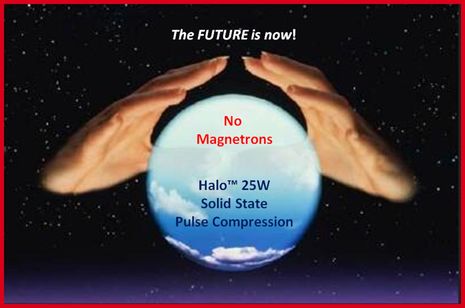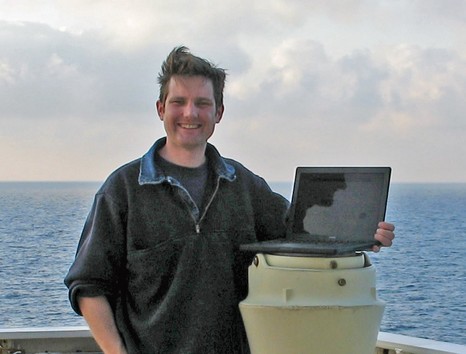SharpEye radar…look, Ma, no magnetron!

I kid you not when I say I’ve had my eye on this product for many months. Now some real info has come to Kelvin Hughes’ SharpEye Web site, though you have to register to get at it, and there still aren’t any actual radar screenshots up yet. No matter, this looks like a major development. SharpEye is a solid state radar transceiver that purportedly uses a tiny fraction of the power demanded by an equivalent scanner, yet is radically better at finding small targets in clutter. It also “extracts the relative motion of targets by measuring the phase of received radar echoes relative to the phase of the transmission.” The first shipping product, in June, will only work with large (4 meter!) existing Kelvin Hughes S band antennas, but they’re working on X band, and rumor has it that this technology will eventually come to recreational boats. I won’t try to explain how “monostatic pulse radar” works, because I don’t know, but you can detect the enthusiasm yourself in places like this Navigation News PDF.














This is extremely interesting.
I am yearning for even the slightly better performance I could get from upgrading from a 2kw 18″ to a 4kw 24″ radar, in detecting small boats.
Needless to say … I would find it very worthwhile to upgrade the radar on my 39 foot sailboat to this technology if it was made available compatible with my E-80 Chartplotter.
Better performance for less power in a smaller package? I can’t wait to see if it really works. They say they’ll introduce the X-band this year. Since there are no displays on the web site for the S-band I’m a little skeptical they’ll meet that schedule, but I’d sure like to be proven wrong!
I read through the site and it’s definitely cool stuff. it’s also an example of the incredible impact cheap, high-performance DSPs are having on many things. The pulse-compression and “chirp Doppler” ranging techniques they describe have been used for years (decades) in military radar systems but the hardware required was massively prohibitive, not to mention very classified. But the essential ideas have been around for a long time, and it’s really cool to see someone with the needed “street cred” run with them moving “down market” from the world of “why use lead when gold will do”.
Would appear that by using chirp technology and having the receiver and display technology available at lower costs will greatly benefit the commercial industry. Only issue I would think is that in the next few years will the S-Band radars continue to operate due to the pressures exerted by the WRC and the conflicts with the cellphone industry? Someone’s gonna have to vacate the 3 GHz spectrum and I suspect there are more lobbyists on the cellphone side than radar side.
SharpEye claims:
“The new S-Band SharpEyeTM system will detect targets in clutter long before conventional radar. It achieves this major performance advantage through the use of a monostatic pulse Doppler solid state transceiver that uses the Doppler effect to determine the target’s velocities. It features advanced pulse compression which processes received echoes into velocity bands enabling it to separate the wanted targets from clutter.”
monostatic: means the transmitter and receiver are in the same place, as is usual for marine radar.
pulse: as usual for marine radar, most radar even.
Doppler effect: Magnetron radar is not coherent, so it cannot use this. This web site shows how doppler info can be used to reduce some sea-clutter:
http://www.radartutorial.eu/11.coherent/co04.en.html
http://www.radartutorial.eu/11.coherent/co05.en.html
pulse compression: magnetrons have high peak power with short pulses. Pulse compression allows the use of lower peak power. In SharpEye’s words: “In the SharpEye radar the solid state power amplifier has a peak output power of just 170W, this contrasts with typical marine radar systems in which the magnetron has a 30kW peak output. But SharpEye produces more energy than the magnetron system therefore exceeding conventional radar in detection performance.”
Here is a technical (but hopefully not too technical explanation):
http://www.radartutorial.eu/08.transmitters/tx17.en.html
This web site has nice side-by-side comparison displays of weather radar using normal pulse and pulse compression:
http://www.sigmet.com/content/sigmetc/news/2005/pulsecomp.pdf
————
Possible improvements in radar using magnetrons:
“Modern advances in signal processing can greatly improve the radar performance in rain or in rough seas, i.e. in clutter; signal processing techniques can do little to improve clear weather radar performance. All such improvements can do is to reduce the degradation of radar performance due to clutter.” … “A cost effective route is to continue the development of reflector antenna technology […] and to employ the best available magnetron radar transmitter/receivers derived from those supplied for marine navigational use, but with additional RF techniques such as the use of frequency diversity, switchable polarisation, and dual band operation.” — quote from
http://www.euinfrastructure.com/pastissue/article.asp?art=272095&issue=229
————
“There is limited commercial magnetron sources and magnetron-based radar scanner suppliers
worldwide (Toshiba, JRC, and EEV being the largest magnetron OEM suppliers who sell to
Furuno, Ray Marine, and other radar scanner makers).”
“Existing magnetron based marine radars are expensive which prevents boater adoption in
high volume numbers. The present magnetron cost typically is 30-40% of the total cost of the
1.5 – 2KW dome scanners. The total RF microwave package costs are 50-60% of the total
radar cost.”
“Low power radar does not exist that addresses minimum needs (sub-16 mile radar for lower
cost than conventional radar). This solid state Tx approach is currently available only in
avionics and military radars.”
These 3 quotes are from
http://www.phlburg.com/solutions/problemstatements/physics/electronics/marineradar.pdf
This site also has a photo of what a marine radar looks like under the covers.
————
JRC is also developing a solid-state S-band marine radar. They claim:
“This allows the radar to transmit wide pulses of hundreds of watts, compared to the traditional magnetron radar which transmits in terms of tens of kilowatts.”
““This is a cutting edge product, far superior to anything in the marketplace,” said Mr. Suwa, the President of Japan Radio Co., Ltd. “It will be of tremendous value to the modern, marine electronics user.””
“The “solid-state” radar sustains the same sensitivity as traditional radar, but the sea and rain-clutter performance will most likely increase. The foremost, significant benefit for the modern, marine electronic user will be the major reduction of maintenance costs.”
http://www.jrc.co.jp/eng/whatsnew/20061219/index.html
————
The IMO thinks solid-state radar is better than magnetron radar:
http://www.iec.ch/online_news/etech/arch_2007/etech_0707/focus.htm
“Although magnetron-based marine radars are good, today’s radar users demand even higher performance capabilities and these come from a surprising place: the Internet.”
“The recent arrival of digital microwave requirements relevant for new Internet applications, such as WiMAX, has helped make the technology affordable for maritime radar. “WiMAX is a high powered wireless Internet technology that is not restricted to a house or block of offices but can perhaps go around a small part of a town. These require higher power semiconductor devices that operate similar to radar frequencies. The advent of those devices means you can use them in radar,” explains Andy Norris, Chairman of TC 80.”
“Much better radar performance comes from combining WiMAX technology with clever technology called pulse compression. “It means we can see small targets in very rough seas and heavy rainfall, which has always been difficult to do,” says Norris.”
“Pulse compression allows maritime radar users to employ the smaller amplitude signals from semiconductor transmitters and preserve the Doppler information in the reflected signal, which is lost in affordable magnetron-based systems. It is the Doppler information (frequency shifts in the returned signal) that can help to distinguish between targets and clutter. This boost in sensitivity allows military performance in commercial marine radar.”
Norse … a lot of information here. What point were you making that this supports ?
Thks
Just background info. Summary: solid-state radar is better than magnetron radar. It’s in the near future for S-band marine radar, but there’s not much sign of it in X-band anytime soon.
My own opinion is that there should be some non-traditional radar options for small boats. With AIS there is less need for long-range radar. I’d like to see radar that specializes in seeing near things better. Perhaps something like the 77 GHz radar that is being experimented with for automotive collision avoidance radar.
Less need for long-range radar, specialize instead in seeing near things better … Agreed !
I would add … with chartplotters, there is no reason to include any coastline beyond five miles, and with Siries or XM, no reason to attempt to use radar to detect distant squalls.
I would imagine if radars need only process information within a five miles of our boats, that would leave more CPU cycles available to track targets and provide functions like ARPA. It would also of course help ARPA implimentation if the radar return included target velocity information for that purpose in addition to clutter reduction.